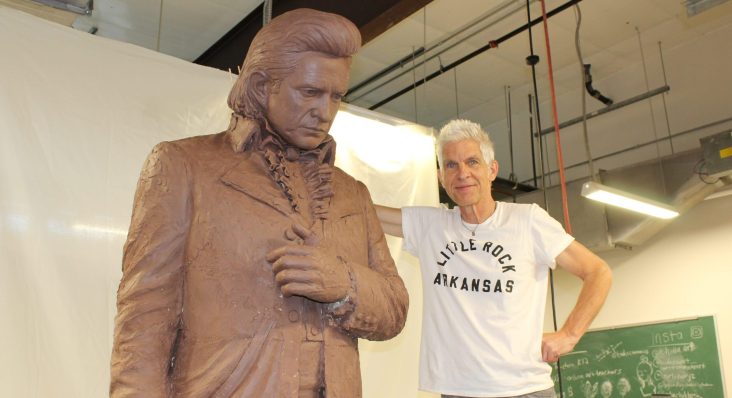Johnny Cash sculptor Kevin Kresse describes statue inspiration
by April 24, 2023 3:51 pm 2,335 views

Artist Kevin Kresse. Photo courtesy of UA Little Rock.
Artist Kevin Kresse had two bold ambitions. When he found out that Arkansas was going to replace its statues with the National Statuary Hall Collection in the U.S. Capitol with ones of Civil Rights icon Daisy Bates and of music hall-of-famer Johnny Cash, he applied to create both sculptures.
He was a finalist for the Bates sculpture, but was picked for Cash. His competitors? One had already done three sculptures in the U.S. Capitol and the other was a lead sculptor for the Lord of the Rings trilogy directed by Sir Peter Jackson.
Kresse beat them when the final decision was rendered in June 2021.
“It was an honor of a lifetime for me to do this,” Kresse said during a recent Jonesboro Kiwanis Club meeting. “The whole thing with Johnny Cash came … naturally.”
Kresse, a Little Rock native is an active painter and sculptor whose works have been displayed all over the United States. He took a keen interest years ago in creating busts of some of Arkansas’ musicians, especially the ones that originated in the Delta.
Long before he was picked to do Cash’s sculpture, he’d done busts of him. Others that he created busts for include Al Green, Sister Rosetta Tharpe, Glen Campbell, Louis Jordan and others.
Cash will be the first musician in the Hall. His statue will be placed in the Hall Visitor Center, National Statuary Hall Steering Committee Chairman Shane Broadway said. Bates will be placed next to a statue of Confederate President Jefferson Davis and adjacent to another civil rights icon Rosa Parks.
Bates is considered a pillar in the Arkansas civil rights movement. She, along with her husband, Lucious Christopher (L.C.) Bates, started the weekly newspaper, the Arkansas State Press, in 1941. It would become the largest African-American newspaper in the state and focused on journalism related issues. It had a statewide reach, distributing in cities such as Little Rock, Pine Bluff, Texarkana, Helena, Forrest City, and Jonesboro.
The U.S. Congress authorized the creation of the Hall in 1864 and each state is allowed two statues. Up to 5 million people from around the world visit the Hall each year.
Building Cash’s sculpture was a painstaking and methodical process, Kresse said. It starts with pictures and mountains of research.
“I’ve got to get to know them. It is not just about the likeness. I want to have a feel for them,” he said.
Kresse’s process included working with a Cash impersonator who lives near Cleveland. The two met in Nashville. Watching him move, replicating Cash’s “gate” was very helpful, he added.
The artist used oil-based clays when the work began. Many times, he would start to work on one part, such as the musician’s hairline, and then he would come back and completely start over. The clay version was then used to create the final bronze version.
“You’ll make yourself nuts doing this,” he said with a laugh.
An element is the storyline for the sculpture itself. In Kresse’s telling, Cash is returning to his boyhood home in Dyess to perform at a concert at the annual Cash Music Festival. His guitar is over his shoulder, a bible is in one hand and he’s clutching his jacket.
“He’s going through the refurbished house. He’s thinking about his brother Jack who died. He’s thinking about his relationship with his father. He’s thinking about the cotton fields that he once toiled in,” he said.
